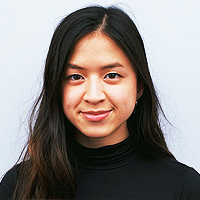That’s not to say that more traditional CVs, despite their condensed black-and-white format, have equally unremarkable content. Unfortunately, in some circumstances, with resumés that are not successful, they may be from candidates that had the potential to bring immense talent it a company —but their CV format did not allow them to stand out.
That’s where the potential for a more “creative CV” can come in. Using free graphic design programs that don’t require any intensive training (you know what I’m talking about…the kind that no amount of YouTube tutorials can prepare you for), you can easily make your CV look sleek and stylish just by adding colour, simple lines, shapes and dividers. Sectioning your experiences and skillset to will allow a more convenient and accessible read for the employer as well.
Feel free to be as experimental as Elle Woods’s pink resumé in Legally Blonde, or go wild by turning it into an interactive game as Robby Leonardi did in 2013. Here are a few tips on how to start and some things to be aware of when deciding which format is best for you.
Stand Out vs. Keeping it Traditional
The creative CV is still kept hush-hush, especially among more “traditional” employers who are used to seeing one-page sheets crammed with all those qualifications and experiences. Just because they expect it doesn’t mean they aren't open to other versions - a CV with colour may catch their attention. What does it say about your personality? You’re bold, innovative and ready to try new things for one, unafraid of departing from conventions. Depending on your job search that could work to your advantage.
But of course this depends on your employer's recruitment process, will the employer even be the one reading your graduate CV? Many companies who receive many applications for one single job vacancy can be more inclined to use bots, as mentioned above, to scan for keywords for example. A creative CV, if in a PDF format, for example, will less likely to be properly scanned by bots as the software may recognise it as an image instead, essentially missing all your information.
Top Tip: It would be well worth doing a little research into the company’s selection processes before submitting a creative resumé - maybe even drop the HR department a line just to check (that way, you can show versatility and awareness - how meta!) whether a PDF file will get through their system in the first place.

Leaving a Strong Impression vs. Leaving the Right Impression
There’s no doubt that a creative CV can leave a strong impression. It’s aesthetically pleasing and therefore can make the viewer more inclined to read it, out of curiosity or approval.
Conversely, it can also seem misleading as if it’s overcompensating perhaps. Some employers care little for design - they opt for the more traditional CV style as it’s easiest to get through, and free of the ‘red herrings’ that are graphics.
For example, Robby Leonardi’s interactive game for a resumé works because he’s a developer. So think about what works with the industry you’re trying to get in - ever thought of a bank statement format for your CV?
Top Tip: Ask yourself, what company is this for? What industry is it? You may think only more ‘creative’ industries, such as that of publishing or media, will want to see a CV that’s carefully designed - but that’s not necessarily true. The HR department will need a break eventually, they’re (usually) human too. A creative CV can be refreshing. You never know it may land you in the ‘approved’ pile straight away.

Less is More vs. Too Selective?
Sometimes less can be more. What a creative CV will need is blank space, to ease the reader’s eyes. It will all you to space out your content, make it easier to concentrate on certain sections, and really narrow down on what you think is most important and relevant to the job.
But that also means making that space. You may find you have to narrow down some of the information you wanted to include so make sure to evaluate your job spec and be strategic when it comes to choosing what you include. For example on sections such as vague skills, and rely on your achievements to reflect that. It’s all a game of compromise - however, will you be taking away too much “just for the aesthetic” and limiting the hard-earned experience you actually have? Remember to balance the aesthetic with content.
Top Tip: The process of assembling a creative CV will in fact help you identify any information you have in there that doesn’t have to be included. It’ll drive home the concept that you don’t need to include every single experience you’ve had, as hard as it is to believe. Narrowing down on specific experiences will really make those shine, and you’ll have ammo from what you didn’t include to talk about in your interview (best of luck!).
Make it Fancy vs. Extra Work But Little Return?
The sky’s the limit for a creative CV, really - you can even go as far as to make a website (although, this will probably be of most benefit if you’re trying to showcase the work you’ve done). If not, sticking to simple free graphic design programs available online can still work exceptionally well.
When it’s application season, do you really have time to rotate a triangle or several shapes around to make it look good on a page? Will the extra work even be worth it at the end of the day? Be sure to ask yourself these questions. Learning how to use a graphic design software incurs the cost of time and can be daunting, especially if this is not something g you have tried before or even familiar with.
Top Tip: Learning how to use graphic design software can be quick for some people, especially for free online ones! They’re usually designed to be user-friendly and require a little experience. It’ll also help with any future tasks you may come across such as infographics or when making promotional flyers. Either way, knowing a popular design software also means you can slip in another entry for your list of IT skills!
The Verdict
At the end of the day, it all comes down to the recurring conclusion that what CV you choose to build should depend on where you’re applying to and the intended audience of your CV.
A creative resumé will be very fitting when applying for a role such as ‘graphic design intern' or maybe even 'press assistant’, but you’ll need to be conscious of the company and do your research. Do review sites point to them being more ‘traditional’, would they want information in a more conventional way to better suit their application process?
Enjoyed this blog? Why not read 6 Top Tips For a Standout Cover Letter or 40 Questions to Expect in a Grad Job Interview




